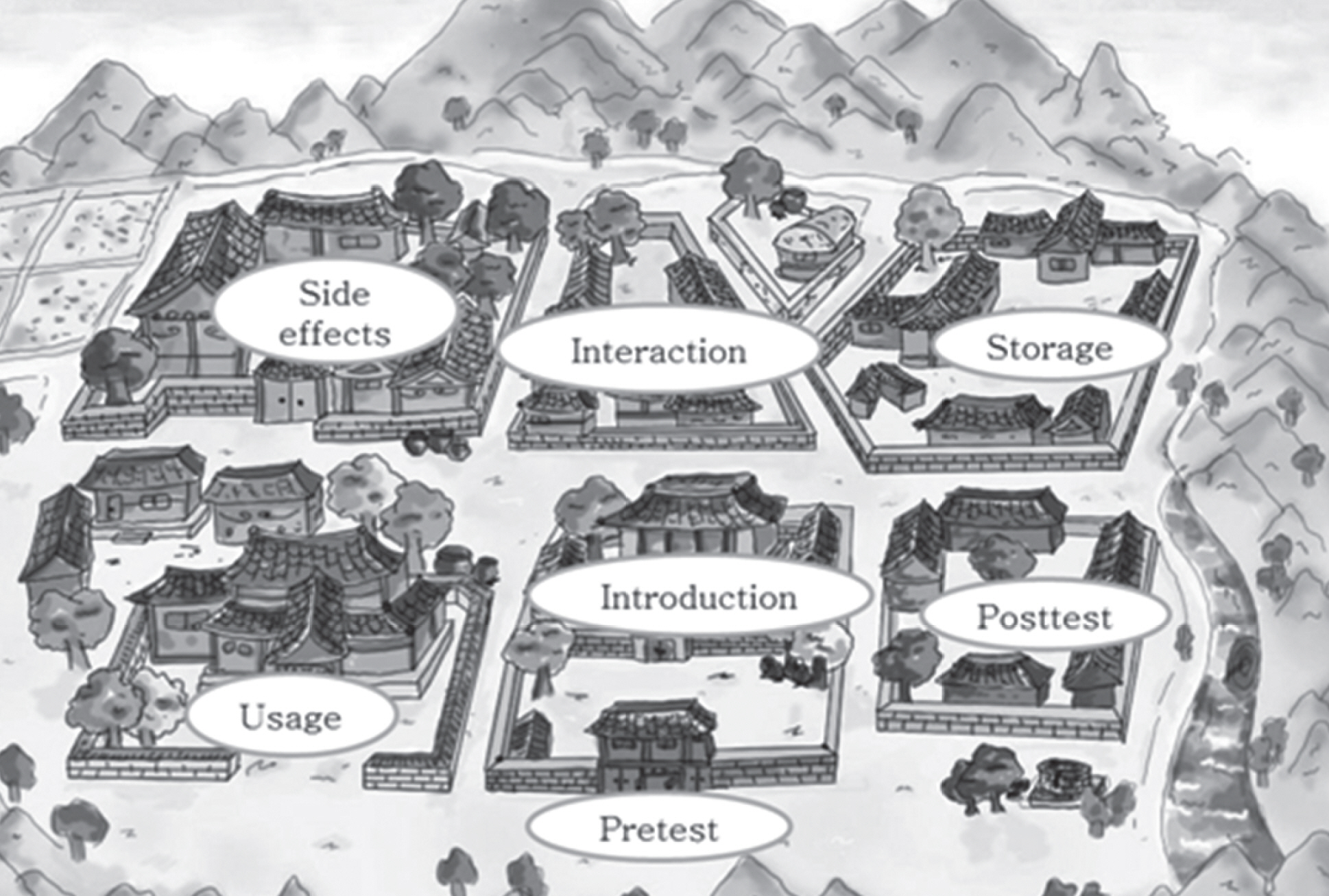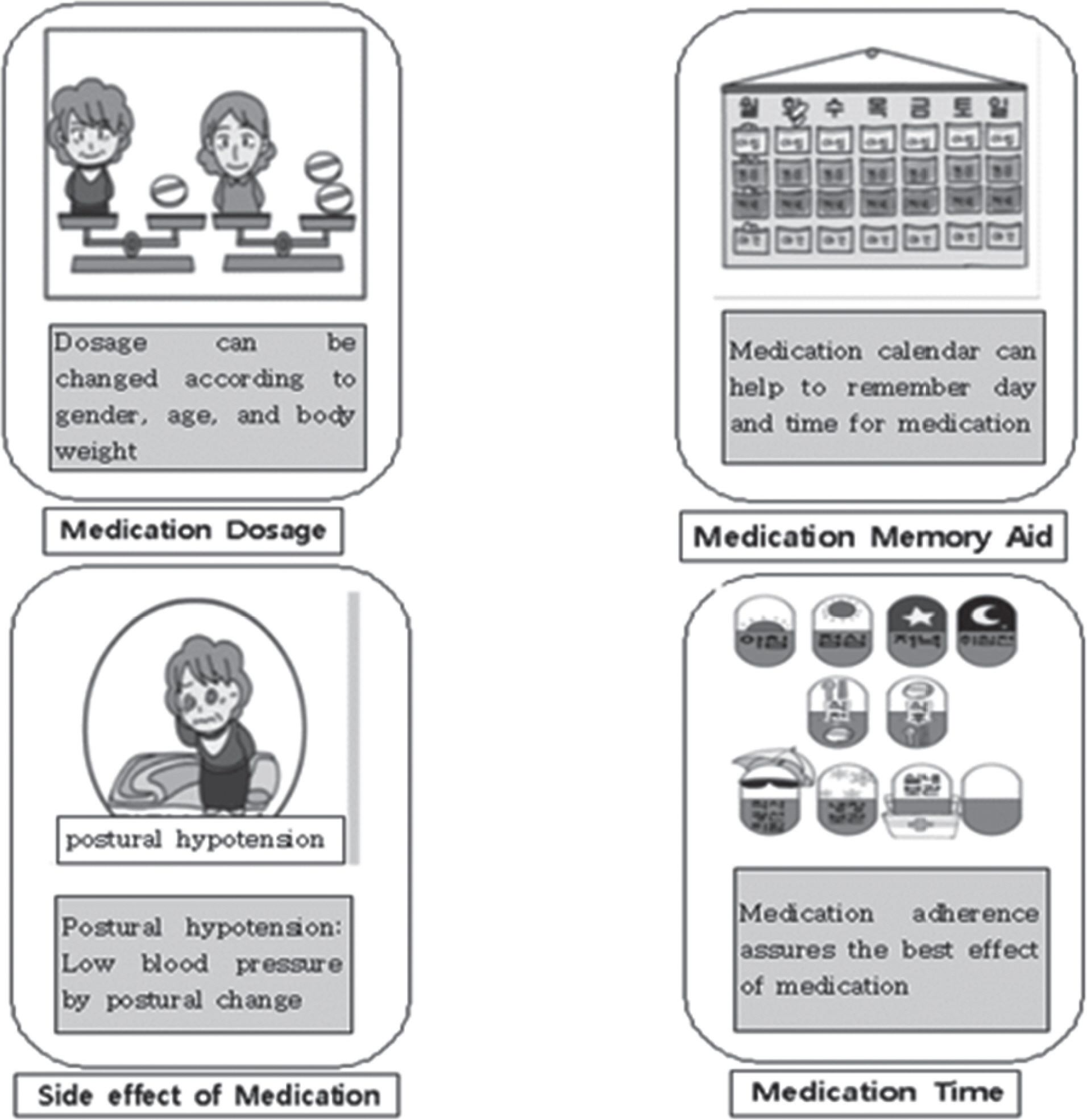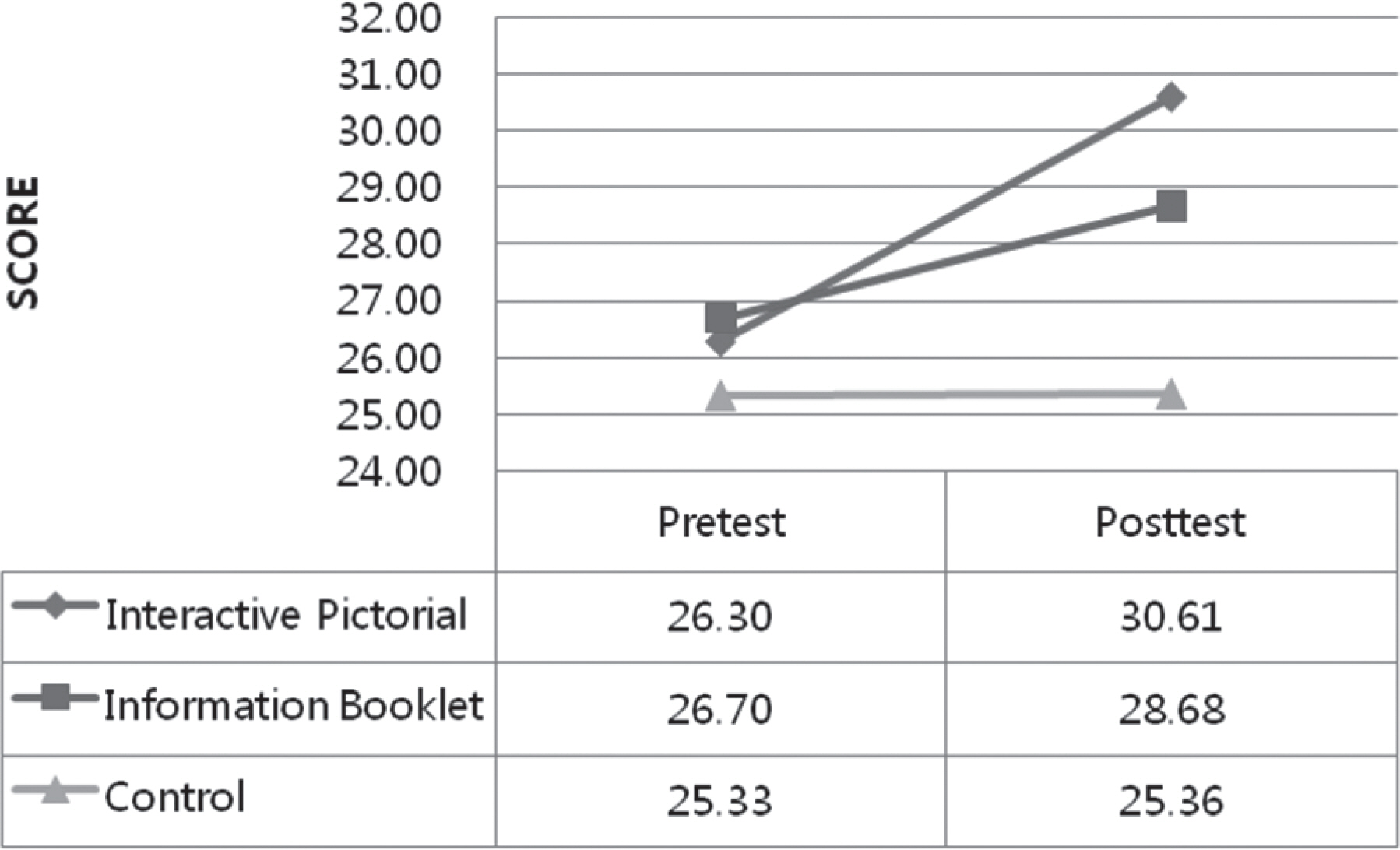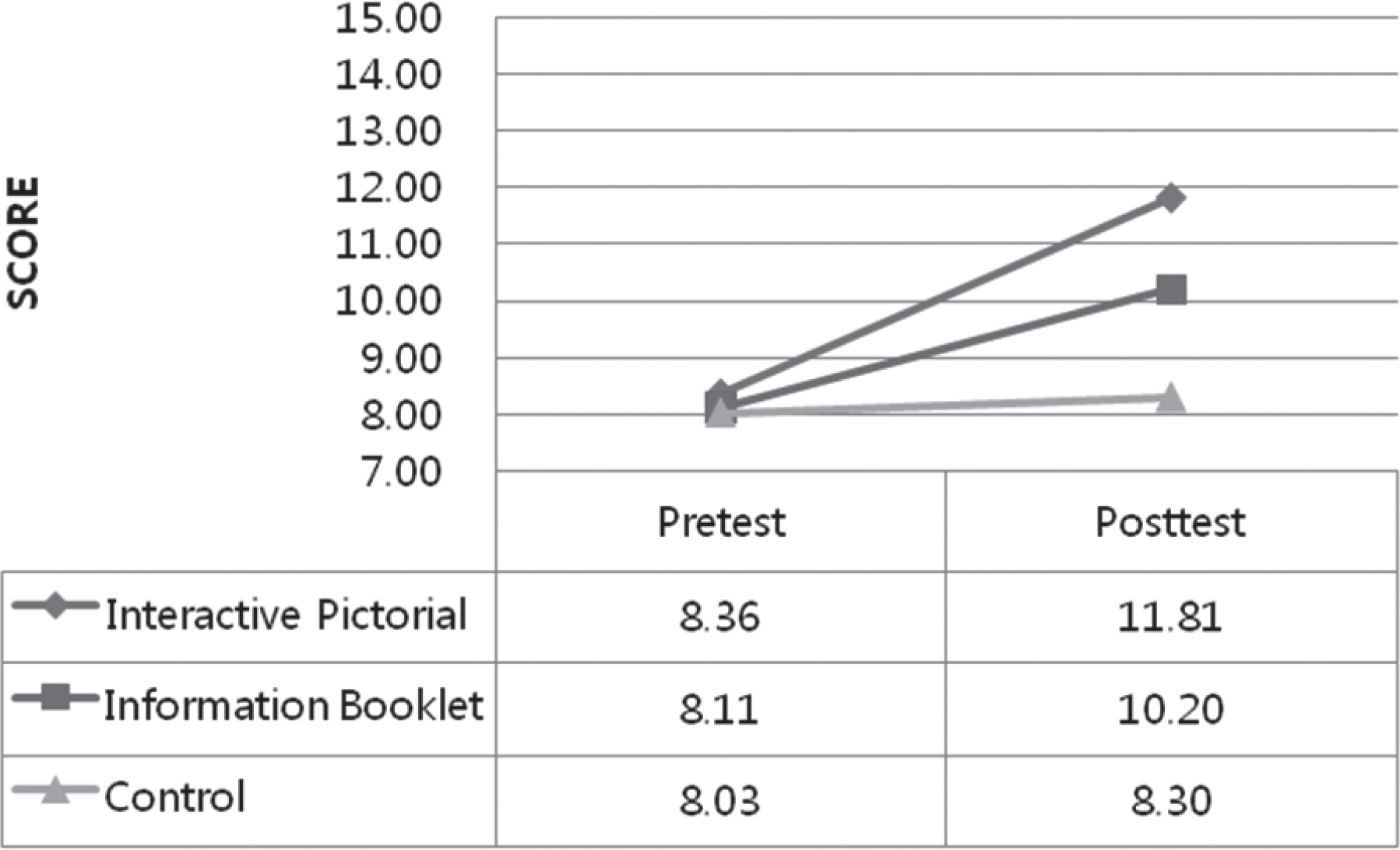Articles
- Page Path
- HOME > J Korean Acad Nurs > Volume 41(6); 2011 > Article
-
Original Article
- Effects of Interactive Pictorial Education on Community Dwelling Older Adult’s Self Efficacy and Knowledge for Safe Medication
- Myonghwa Park
-
Journal of Korean Academy of Nursing 2011;41(6):795-804.
DOI: https://doi.org/10.4040/jkan.2011.41.6.795
Published online: December 12, 2011
Associate Professor, College of Nursing, Chungnam National University, Daejeon, Korea
Associate Professor, College of Nursing, Chungnam National University, Daejeon, Korea
- Address reprint requests to : Park, Myonghwa College of Nursing, Chungnam National University, 55 Munhwa-ro, Jung-gu, Daejeon 301-747, Korea Tel: +82-42-580-8328 Fax: +82-42-580-8309 E-mail: mhpark@cnu.ac.kr
Copyright © 2011 Korean Society of Nursing Science
This is an Open Access article distributed under the terms of the Creative Commons Attribution Non-Commercial License (http://creativecommons.org/licenses/by-nc/3.0) which permits unrestricted non-commercial use, distribution, and reproduction in any medium, provided the original work is properly cited.
Abstract
-
Purpose
- The purpose of this study was to examine the effects of interactive pictorial education on community dwelling older Korean adults’ self-efficacy and knowledge for safe medication.
-
Methods
- A quasi-experimental, three-group pre- and post-intervention design was used in this study. The interactive pictorial education was designed to suit the learning patterns and psychomotor skills of older adults. The education content, dealing with safe medication, was delivered over three sessions. A total of 136 older adults from local senior centers were assigned to one of the three groups: a) interactive pictorial education plus information booklet (experimental); b) education only with information booklet (conventional); or c) no intervention (control).
-
Results
- Participants receiving interactive pictorial education had significantly higher self-efficacy (F=24.32, p<.001) and knowledge (F=24.26, p<.001) scores than the information booklet or control group at post intervention. Post-hoc analyses indicated that both the interactive pictorial and the information booklet groups had significantly higher self-efficacy and knowledge scores than the control group at the post-test point (p<.05). Furthermore, the interactive pictorial group had higher self-efficacy and knowledge scores than the information booklet group at the post-test point (p<.05).
-
Conclusion
- These results suggest that the interactive pictorial education is an innovative approach that provides a means for older adults to learn appropriate medication use to improve their own health. It empowers older adults with different literacy levels to enhance their self-efficacy and knowledge for the safe use of medication.
| Source | SS | df | Mean Square | F | p |
|---|---|---|---|---|---|
| Self Efficacy* | 24.32 | <.001 | |||
| Between groups | 734.01 | 2 | 367.01 | ||
| Within groups | 2,671.10 | 133 | 15.09 | ||
| Total | 3,405.11 | 135 | |||
| Knowledge† | |||||
| Between groups | 214.21 | 2 | 107.11 | 24.26 | <.001 |
| Within groups | 781.45 | 133 | 4.42 | ||
| Total | 995.66 | 135 |
*post-hoc Tukey’s test: The interactive pictorial education plus information booklet group >education only with information booklet group >no intervention group;
†post-hoc Tukey’s test: The interactive pictorial education plus information booklet group >education only with information booklet group >no intervention group.
- Andrus M R &, Roth M T. 2002;Health literacy: A review. Pharmacotherapy. 22:282–302. doi: 10.1592/phco.22.5.282.33191.ArticlePubMed
- Bandura A. 1986.Social foundations of thought and action: A social cognitive theory. 2nd ed.Englewood Cliffs, NJ: Prentice Hall.
- Bloom B. 1956.Taxonomy of educational objectives, hand-book 1: Cognitive domain. Longman, NY: David McKay.
- Cohen J. 1988.Statistical power analysis for behavioral sciences. Hillsdale, NJ: Lawrence Erlbaum Associates Inc..
- DiMatteo M R. 2004;Variations in patients’ adherence to medical recommendations: A quantitative review of 50 years of research. Medical Care. 42:200–209. doi: 10.1097/01.mlr.0000114908.90348.f9.PubMed
- Dowse R &, Ehlers M. 2005;Medicine labels incorporating pictograms: Do they influence understanding and adherence? Patient Education and Counseling. 58:63–70. doi:10.1016/j.pec.2004.06.012.ArticlePubMed
- Fialova D, Topinkova E, Gambassi G, Schroll M, Onder G, Sorbye L W. . 2005;Potentially inappropriate medication use among elderly home care patients in Europe. Te Journal of the American Medical Association. 293:1348–1358. doi: 10.1001/jama.293.11.1348.Article
- Grant J &, Davis L. 1997;Selection and use of content experts for instrument development. Research in Nursing and Health. 20:269–274. doi: 10.1002/(SICI)1098-240X(199706)20:3<269::AID-NUR9>3.0.CO;2-G.ArticlePubMed
- Han K S, Moon S Y, Park H O &, Park E H. 2000;The survey on the drug use status, knowledge and attitude of college students -Seoul and northern part of the Kyunggi-do. Te Journal of Korean Academic Society of Nursing Education. 6:376–389.
- Han J H. 2007;Te infuence of cognitive function, their family support and medication knowledge upon medication adherence in old people. Unpublished master’s thesis, Ewha Womans University, Seoul.
- Hill L H. 2004;Concept mapping in a pharmacy communications course to encourage meaningful student learning. American Journal of Pharmaceutical Education. 68:109. Article
- Houts P S, Doak C C, Doak L G &, Loscalzo M J. 2006;The role of pictures in improving health communication: A review of research on attention, comprehension, recall, and adherence. Patient Education and Counseling. 61:176–190.Article
- Katz M Z, Kripalani S &, Weiss B D. 2006;Use of pictorial aids in medication instructions: A review of the literature. American Journal of Health System Pharmacy. 63:2391–2397. doi:10.2146/ajhp060162.ArticlePubMed
- Kripalani S, Robertson R, Love-Ghaffari M A, Henderson L E, Praska J, Strawder A. . 2007;Development of an illustrated medication schedule as a low-literacy patient education tool. Patient Education and Counseling. 66:368–377. doi:10.1016/j.pec.2007.01.020.ArticlePubMed
- Lee S &, Park M. 2010;A study on health literacy, medication knowledge, and medication misuse of rural elderly. Journal of the Korean Gerontological Society. 30:485–497.
- Lee J H &, Park M H. 2007;The effects of an education program for safe drug use in the rural elderly. Journal of Korean Academy of Nursing. 37:295–304.ArticlePubMedPDF
- Lee T H &, Kang S J. 2008;Actual condition and influence of Korean elderly health literacy. Journal of the Korean Gerontological Society. 28:847–863.
- Lin C A, Neafsey P J &, Strickler Z. 2009;Usability testing by older adults of a computer-mediated health communication program. Journal of Health Communication. 14:102–118. doi: 10.1080/10810730802659095.ArticlePubMedPMC
- Mansoor L E &, Dowse R. 2004;Design and evaluation of a new pharmaceutical pictogram sequence to convey medicine usage. Ergonomics Society of South America. 2:29–41.
- Ministry of Health and Welfare. 2009.2008 Korean elderly survey. Seoul: The Author.
- Molassiotis A, Nahas-Lopez V, Chung W Y, Lam S W, Li C K &, Lau T F. 2002;Factors associated with adherence to antiretroviral medication in HIV-infected patients. International Journal of STD & AIDS. 13:301–310. doi: 10.1258/0956462021925117.ArticlePDF
- Neafsey P J, Strickler Z, Shellman J &, Padula A T. 2001;Delivering health information about self-medication to older adults. Journal of Gerontological Nursing. 27(11):19–27.Article
- Neafsey P J, Anderson E, Coleman C, Lin C A, M’lan C E &, Walsh S. 2009;Reducing adverse self-medication behaviors in older adults with the next generation personal education program: Design and methodology. Journal of Patient Preference and Adherence. 6:323–334. doi: 10.1007/s12126-010-9085-9.
- Owen S V. 1993.Professor test scoring manual (revised). Storrs, CT: Bureau of Educational Research and Service. University of Connecticut.
- Park M S. 2008;Drug use in the elderly. Journal of Korean Academy of Nursing. 15:195–205.
- Risser J, Jacobson T A &, Kripalani S. 2007;Development and psychometric evaluation of the self-efficacy for appropriate medication use scale (SEAMS) in low-literacy patients with chronic disease. Journal of Nursing Measurement. 15:203–219. doi: 10.1891/106137407783095757.ArticlePubMed
- Sawhney B B &, Reicherter E A. 2005;Literacy and the older adult: Educational considerations for health professionals. Topics in Geriatric Rehabilitation. 21:275–281.Article
- Scherer Y K &, Bruce S. 2001;Knowledge, attitudes, and self-efficacy and compliance with medical regimen, number of emergency department visits, and hospitalizations in adults with asthma. Heart & Lung: Te Journal of Acute and Critical Care. 30:250–257. doi: 10.1067/mhl.2001.116013.Article
- Shin K R, Kim J S, Kim J Y &, Yi H R. 2005;Effects of a drug misuse and abuse prevention program on knowledge, attitude, and preventive behaviors related to drug misuse and abuse, and depression in low-in-come elderly women. Journal of Korean Academy of Nursing. 35:763–773.ArticlePubMedPDF
- Sojourner R J &, Wogalter M S. 1998;The influence of pictorials on the comprehension and recall of pharmaceutical safety and warning information. International Journal of Cognitive Ergonomics. 2:93–106.
- Wilson F L, Mood D &, Nordstrom C K. 2010;The influence of easy-to-read pamphlets about self-care management of radiation side effects on patients’ knowledge. Oncology Nursing Forum. 37:774–781. doi: 10.1188/10.ONF.774-781.ArticlePubMed
REFERENCES
Figure & Data
REFERENCES
Citations

- Physiotherapist-targeted strategies and tools for recognising patients with limited health literacy and adapting physiotherapeutic communication: A scoping review
Nicole Bruin, Harriet Wittink, Janke Oosterhaven, Arlette Hesselink, Hans Hobbelen, Sandra Lakke
Patient Education and Counseling.2025; 137: 108784. CrossRef - Factors Influencing Medication Adherence among Adult Patients with Hypertension
Soo Kyung Lee, Myung Sun Hyun
The Korean Journal of Rehabilitation Nursing.2025; 28(1): 1. CrossRef - Are interactive and tailored data visualizations effective in promoting flu vaccination among the elderly? Evidence from a randomized experiment
Lynne M Cotter, Sijia Yang
Journal of the American Medical Informatics Association.2024; 31(2): 317. CrossRef - The effect of teach‐back versus pictorial image educational methods on knowledge of renal dietary restrictions in elderly hemodialysis patients with low baseline health literacy
Mohammad Sadegh Mozafari, Fereshteh Besharati, Parand Pourghane, Bahareh Gholami‐Chaboki
Hemodialysis International.2024; 28(1): 92. CrossRef - A rapid review of interventions to improve medicine self‐management for older people living at home
Giorgia Previdoli, V‐Lin Cheong, David Alldred, Justine Tomlinson, Savi Tyndale‐Biscoe, Jonathan Silcock, Daniel Okeowo, Beth Fylan
Health Expectations.2023; 26(3): 945. CrossRef - Development and effectiveness of an integrated medication management program centered on senior welfare centers for older adults with hypertension: A cross-sectional study
Heuijeong Moon, Dukyoo Jung
Journal of Korean Gerontological Nursing.2023; 25(3): 297. CrossRef - The Effect of Nursing Interventions for Rational Drug Use and Raising Awareness in Older Adults: A Randomized Controlled Study Protocol
Tuğçe Salbur, Büşra Altınel, Ayse Cal
Black Sea Journal of Health Science.2023; 6(3): 439. CrossRef - Effect of self-management education using pictogram-based content of health information on outcomes in Korean patients with chronic obstructive pulmonary disease: A randomized controlled trial
Ja Yun Choi, Eui Jeong Ryu, Xin Jin
Geriatric Nursing.2023; 54: 324. CrossRef - The association between self-efficacy and self-care in essential hypertension: a systematic review
Felicia Clara Jun Hui Tan, Prawira Oka, Hajira Dambha-Miller, Ngiap Chuan Tan
BMC Family Practice.2021;[Epub] CrossRef - Medication Adherence and the Role of Pictograms in Medication Counselling of Chronic Patients: a Review
Piotr Merks, Jameason Cameron, Krzysztof Bilmin, Damian Świeczkowski, Tomira Chmielewska-Ignatowicz, Tomasz Harężlak, Katarzyna Białoszewska, Katarina Fehir Sola, Miłosz J Jaguszewski, Regis Vaillancourt
Frontiers in Pharmacology.2021;[Epub] CrossRef - Effects of health literacy interventions on health-related outcomes in socioeconomically disadvantaged adults living in the community: a systematic review
Coraline Stormacq, Jacqueline Wosinski, Evelyne Boillat, Stephan Van den Broucke
JBI Evidence Synthesis.2020; 18(7): 1389. CrossRef - Interventions for improving medication-taking ability and adherence in older adults prescribed multiple medications
Amanda J Cross, Rohan A Elliott, Kate Petrie, Lisha Kuruvilla, Johnson George
Cochrane Database of Systematic Reviews.2020;[Epub] CrossRef - The Effect of a Tailored Health Education Programme on Medication Management in the Elderly
Salma Mohamed Samir El Said, Ghada Essam El-Din Amin, Essam Mohamed Baumy Helal, Reham Salah Amin Radwan, Hoda MF Wahba
The Scientific World Journal.2020; 2020: 1. CrossRef - e-Learning for the elderly on drug utilization: A pilot study
Victoria Throfast, Lina Hellström, Bo Hovstadius, Göran Petersson, Lisa Ericson
Health Informatics Journal.2019; 25(2): 227. CrossRef - Depression and medication adherence among older Korean patients with hypertension: Mediating role of self‐efficacy
Youn‐Jung Son, Mi Hwa Won
International Journal of Nursing Practice.2017;[Epub] CrossRef - A Persian Adaptation of Medication Adherence Self-Efficacy Scale (MASES) in Hypertensive Patients: Psychometric Properties and Factor Structure
Mohsen Saffari, Isa Mohammadi Zeidi, Bengt Fridlund, Hui Chen, Amir H. Pakpour
High Blood Pressure & Cardiovascular Prevention.2015; 22(3): 247. CrossRef - Development and Evaluation of a Computerized Multimedia Approach to Educate Older Adults about Safe Medication
Choongjae Im, Myonghwa Park
Asian Nursing Research.2014; 8(3): 193. CrossRef - Lifelong Learning in Old Age: Results from the Belgian Ageing Studies
Liesbeth De Donder, Dorien Brosens, Nico De Witte, Tine Buffel, Sarah Dury, An-Sofie Smetcoren, Dominique Verté
Procedia - Social and Behavioral Sciences.2014; 116: 513. CrossRef - The Impacts of using community health volunteers to coach medication safety behaviors among rural elders with chronic illnesses
Chi-Jane Wang, Susan J. Fetzer, Yi-Ching Yang, Jing-Jy Wang
Geriatric Nursing.2013; 34(2): 138. CrossRef




Figure 1.
Figure 2.
Figure 3.
Figure 4.
| Characteristic | Categories | Interactive pictorial (n=45) |
Information booklet (n=45) |
Control (n=46) |
χ² or F | p |
|---|---|---|---|---|---|---|
| n (%) | n (%) | n (%) | ||||
| Gender | Male | 21 (46.7) | 22 (48.9) | 22 (47.8) | 10.50 | .228 |
| Female | 24 (53.3) | 23 (51.1) | 24 (52.2) | |||
| Age (yr) | 65-69 | 7 (15.6) | 9 (20.0) | 7 (15.6) | 5.52 | .523 |
| 70-74 | 12 (26.7) | 14 (31.1) | 11 (24.4) | |||
| 75-79 | 10 (22.2) | 10 (22.2) | 13 (28.9) | |||
| ≥80 | 16 (35.6) | 12 (26.7) | 14 (31.1) | |||
| M (SD) | 76.0 (6.5) | 74.6 (5.8) | 76.8 (6.0) | 76.0 (6.0) | ||
| Education | None (illiterate) | 4 (8.9) | 5 (11.1) | 5 (10.9) | 6.91 | .103 |
| level | None (literate) | 6 (13.3) | 6 (13.4) | 7 (15.2) | ||
| Elementary | 23 (51.1) | 22 (48.9) | 22 (47.8) | |||
| Middle school | 10 (22.2) | 11 (24.4) | 10 (21.7) | |||
| ≥High school | 2 (4.4) | 1 (2.2) | 2 (4.4) | |||
| Marital status | Married | 20 (44.4) | 20 (44.4) | 19 (41.3) | 1.90 | .070 |
| Bereavement | 22 (48.9) | 23 (51.2) | 25 (54.3) | |||
| Divorced | 3 (6.7) | 2 (4.4) | 2 (4.4) | |||
| Income | Low | 15 (33.3) | 14 (31.1) | 14 (30.4) | 6.01 | .786 |
| Medium | 17 (37.8) | 20 (44.4) | 20 (43.5) | |||
| High | 13 (28.9) | 11 (24.4) | 12 (26.1) | |||
| Health | Very good | 5 (11.2) | 7 (15.6) | 5 (10.9) | 2.05 | .057 |
| condition | Good | 12 (26.7) | 9 (20.0) | 13 (28.3) | ||
| Fair | 20 (44.4) | 21 (46.7) | 19 (41.3) | |||
| Somewhat bad | 6 (13.3) | 6 (13.3) | 8 (17.4) | |||
| Very bad | 2 (4.4) | 2 (4.4) | 1 (2.1) | |||
| Number of | 0 | 1 (2.2) | 3 (6.7) | 2 (4.3) | 1.81 | .454 |
| medical | 1 | 20 (44.4) | 18 (40.0) | 20 (43.6) | ||
| diagnosis | 2 | 18 (40.0) | 12 (26.7) | 14 (30.4) | ||
| 3 | 5 (11.1) | 9 (20.0) | 8 (17.4) | |||
| 4 | 1 (2.3) | 3 (6.6) | 2 (4.3) | |||
| Number of | 1-2 | 20 (44.4) | 17 (37.8) | 18 (39.1) | 0.23 | .891 |
| medication | 3-4 | 18 (40.0) | 20 (44.4) | 19 (41.3) | ||
| Over 5 | 7 (15.6) | 8 (17.8) | 9 (19.6) |
| Measurement | Interactive pictorial (n=45) |
Information booklet (n=45) |
Control (n=46) |
F | p |
|---|---|---|---|---|---|
| Mean±SD | Mean±SD | Mean±SD | |||
| Self-efficacy | 26.30±3.92 | 26.70±3.20 | 25.33±4.06 | 5.55 | .406 |
| Knowledge | 8.36±1.88 | 8.11±2.09 | 8.03±1.81 | 2.60 | .267 |
| Source | SS | df | Mean Square | F | p |
|---|---|---|---|---|---|
| Self Efficacy |
24.32 | <.001 | |||
| Between groups | 734.01 | 2 | 367.01 | ||
| Within groups | 2,671.10 | 133 | 15.09 | ||
| Total | 3,405.11 | 135 | |||
| Knowledge |
|||||
| Between groups | 214.21 | 2 | 107.11 | 24.26 | <.001 |
| Within groups | 781.45 | 133 | 4.42 | ||
| Total | 995.66 | 135 |
post-hoc Tukey’s test: The interactive pictorial education plus information booklet group >education only with information booklet group >no intervention group; post-hoc Tukey’s test: The interactive pictorial education plus information booklet group >education only with information booklet group >no intervention group.
 KSNS
KSNS
 E-SUBMISSION
E-SUBMISSION




 Cite
Cite

